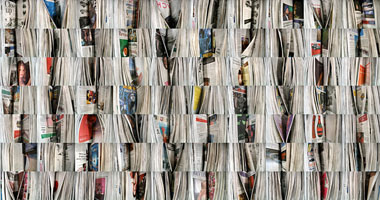Barbara Astman
Barbara Astman, photographer, multimedia artist (b at Rochester, NY 12 July 1950). Astman is a graduate of Rochester Institute of Technology (1970) and Ontario College of Art (1973). Her camera works and sculptural installations are a mixture of various traditional art forms - such as drawing, painting, photography, and sculpture, redefined by a contemporary sensibility. A fascination with current technology has resulted in images of remarkable colour, texture and scale.
Her Red series (1980) represented a breakthrough on several levels: symbolism, content and form. In this series, the artist was posed frontally amidst a carefully balanced composition of objects, each spray-painted red, which because of their redness assumed a variety of implications at once playful and vaguely threatening. In the Places series (1982) she explored the traditional dimension of sculptural assemblage - mixed-media construction of linoleum, wood and plastics. The spatial hieroglyphs in this series were abstractions based on personal memories.
A strong interest in constructivism and theatrical set design dominated Settings for Situations (1984),elegant formal wood constructions mounted on the wall and placed on the floor. An exploration of the theatrical curtain and its nuances of dramatic expectation was evidenced in the evocative Curtain series (1988) of striking red/black Ektacolour murals and the commissioned backlit billboard for the Art on Billboards project for the 1988 Calgary Olympic Winter Games.
The commissioned work produced in the 1990s and continuing into the 21st century represents a daring new direction incorporating starkly contrasting themes expressed in architecture, landscape architecture, and photography. Her commissions include the linoleum floor for the Olympic Speedskating Oval, Calgary (1988); cast concrete paving stones for the Conservatory Tower, Toronto; cognitive map in etched glass, St Laurent Recreation Centre, near Ottawa; and interior glass panels for Simcoe Place, Toronto. The Portal Project for the Baycrest Centre for Geriatric Care, Toronto, 1999, consists of digital photomurals for 2 series of 6 residential entrances. The murals act as visual way-finders for the patients. In 2004 the artist created a series of 14 etched exterior glass windows, based on Jewish history and culture for the Wolfond Centre for Jewish Campus Life, University of Toronto. The etched imagery surrounds the spiritual room and acts as a signifier for the building's identity.
Astman completed The Weather Windows commission for the opening of the new Canadian Embassy, Berlin, Germany in 2005. This integrated art and architecture work comprises an image based on weather as a national identity factor, with a ceramic frit applied to the glass tower surrounding the Timber Hall. Also in 2005, the artist completed a commissioned series of large murals for the new Loblaw Headquarters, Brampton, Ontario. More recently, The Murano on Bay public art project, Toronto, which incorporated coloured photographic imagery embedded in 217 large scale exterior windows surrounding the second and third floors of the building is scheduled for completion in Fall 2009.
In addition to her commissioned artworks, Barbara Astman has continued to produce non-commissioned works, usually in series. Untitled (Fruit Series), 1990, Untitled (Rock Series), 1991-93, and Untitled (Seeing and Being Seen), 1994 represent a startling combination of overtly classical themes, overlaid with psychological concerns related to sensuality, aging, maturity and spiritual issues. Scenes from a Movie for One (1996-97), abstractions of the upper torso and head, depict the psychological ambiguity inherent in pain and conflicting life forces.
The Emergence Series (1998) dealt with the growing prominence of women in the workplace, specifically in the legal profession. The Dreaming Impressionism series also completed in 1998 re-examined traditional art history textbook narratives by re-contextualizing female figures depicted in various impressionists paintings and re-combining them to create new figural arrangements.
The Paris Postcards Series (2001), was inspired by the artist's collection of 700 historical postcards obtained while travelling in Paris. The resulting images comprised sections of postcards, layered to create new visual narratives. Dancing with Che, 2003, is the black and white photographic documentation of an imagined private performance in which Che Guevera becomes the artist's dance partner. The t-shirt image of Che, a pop-culture icon, comes alive as the artist sways and moves to the beat of Cuban music.
The Clementine Suite (2005), continued the artist's explorations around the nature of memory and the photographic image. A photograph depicting a group of Jewish orphans on their way from Europe to Canada in 1947 was the inspiration for her series of installations, which utilize ready-made lighting systems. The faces of these orphans became the focus of Astman's memorial-based work celebrating survival.
The Newspaper Series (2007), addressed the role of the accumulation of images in our media-obsessed culture. Comprising 52 seven-image collages, intended to mimic the daily and weekly cycles of news media, the series grew out of Astman's interest in print-based media and her fears for its potential demise.
Barbara Astman returned to the Che Guevera theme in 2011 with an exhibition at the Kelowna Art Gallery entitled Dancing With Che: Enter Through the Gift Shop. The installation artwork comprised a mock gift shop, completely given over to "souvenir" items displaying Astman's image of herself wearing her "Che Guevera" t-shirt. The sub-title, Enter Trough the Gift Shop made direct reference to the title of the 2010 film, Exit Trough the Gift Shop, by British graffiti artist Banksy, echoing both artists' views on the contemporary trend towards the commodification of art.
In 2008, Astman completed a curatorial project for the November 2008 re-opening of Frank Gehry's addition to the Art Gallery of Ontario, with works selected from the AGO collection. The project was based on the art of Joyce Wieland and early feminist practice in 1960s and 1970s Canada.
Astman is a senior art professor at the Ontario College of Art and Design, where she has mentored students since the mid 1970s. She has also served on numerous national and international competition juries.
The catalogue Barbara Astman, personal persona: a 20 year survey, documents her 1995 touring retrospective, organized by the Art Gallery of Hamilton. Selected public collections include the Bibliothque Nationale, Paris; Canadian Museum of Contemporary Photography; Museum of Fine Arts, Houston; National Gallery of Canada; Victoria and Albert Museum, London: UBS, Switzerland and numerous prestigious private collections. Astman received a silver National Magazine Award for The Newspaper Series, presented in Prefix magazine, Toronto, 2007.

 Share on Facebook
Share on Facebook Share on X
Share on X Share by Email
Share by Email Share on Google Classroom
Share on Google Classroom




